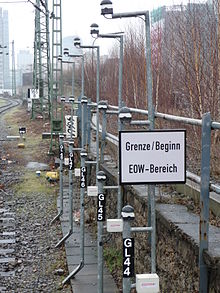Electrically set points
An electrically localized turnout or EOW is an electrically powered railway turnout that is not operated from an interlocking , but from the point of turnout. EOW are the modern equivalent of the manual turnout and are mainly used in track systems where only free shunting is possible. The route closures and route fixing necessary for train and shunting routes are mostly missing.
EOWs must not be confused with switches in the local control area . These can only be operated temporarily on site and can be integrated into routes when the local control area is switched off.
The operation of locally set electrical points is typically done at preferred control points using so-called push buttons, also known as palm buttons. These are large buttons similar to emergency stop switches or the buzzers on quiz shows. These are mounted on stands in front of the switch on the route (often several buttons at different heights) so that they can be operated through the side window or from the shunting step of a motor vehicle slowly passing by. Occasionally, the push buttons are also attached directly to the switch. Alternatively, EOW can be provided by the shunting attendant or train driver using a display board in the track area. This has the advantage that several points can be set from one location and the speed does not have to be reduced before each point. A distinction is made between:
- Control panel (BT): They are used where only one destination is to be reached from a starting point
- Route control board (FT): By selecting a target track, a route can be made up of several points
- Switchboard (WT): Several switches can be set from one switchboard
Electrically set points are often equipped with a track vacancy detection for the point area, which prevents the switch from being changed when it is occupied. With such EOW a remote control, z. B. with radio, permitted. The rail contacts also offer the possibility of triggering the changeover process when the points are butted. In this case, no operator intervention is necessary.
What is striking are the turnout signals, which are only used by EOW and are designed as light signals, in the form of signal lamps arranged next to and one above the other in a common box. These turnout position and order indicators (WLM) give the driver the information about the position of the turnout, that the turnout is circulating or whether there is a turnout fault.
EOW can also be equipped with a preferred layer. They run back into this automatically if they were driven on and cleared in the non-preferred position. The preferred position is marked on the switch position indicator with a white stripe.
Compared to manual turnouts, EOWs have various advantages in railway operations. Instead of stopping the shunting run, getting off the locomotive, using muscle power to flip the (possibly poorly lubricated or frozen) hand switch, climbing back up and starting again, the driver can drive through. This not only means increased safety and an improvement in occupational health, since the train driver does not have to step into the track and there is no need to climb and switch points, but it also speeds up routes with several local switches considerably.
In January 2006, Deutsche Bahn had 40 EOW areas with 808 actuating units. EOW z. B. in the tracks around Frankfurt (Main) Hbf , where they were installed in rows as part of the interlocking conversion. Entire batteries of filigree, black and yellow striped stands with several push buttons can be seen from many tracks at the entrance to the station.
EOWs are manufactured and approved by many railway operators themselves.
Individual evidence
- ↑ Maschek, Ulrich: Securing rail traffic, basics and planning of control and safety technology . 3rd, revised. u. exp. Edition 2015. Springer Fachmedien Wiesbaden, Wiesbaden 2015, ISBN 978-3-658-10757-4 .
- ↑ Jörg Bormet: Requirements of the operator on the life cycle in route safety technology . In: signal + wire . tape 99 , no. 1 + 2 , 2007, ISSN 0037-4997 , p. 6-16 .


